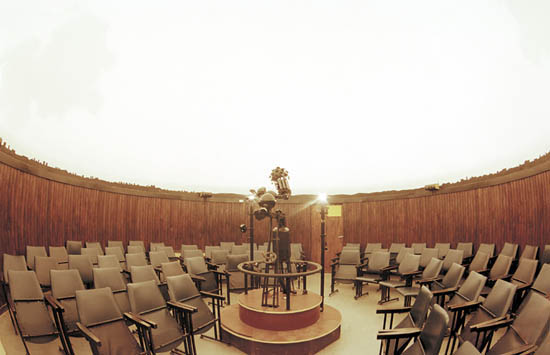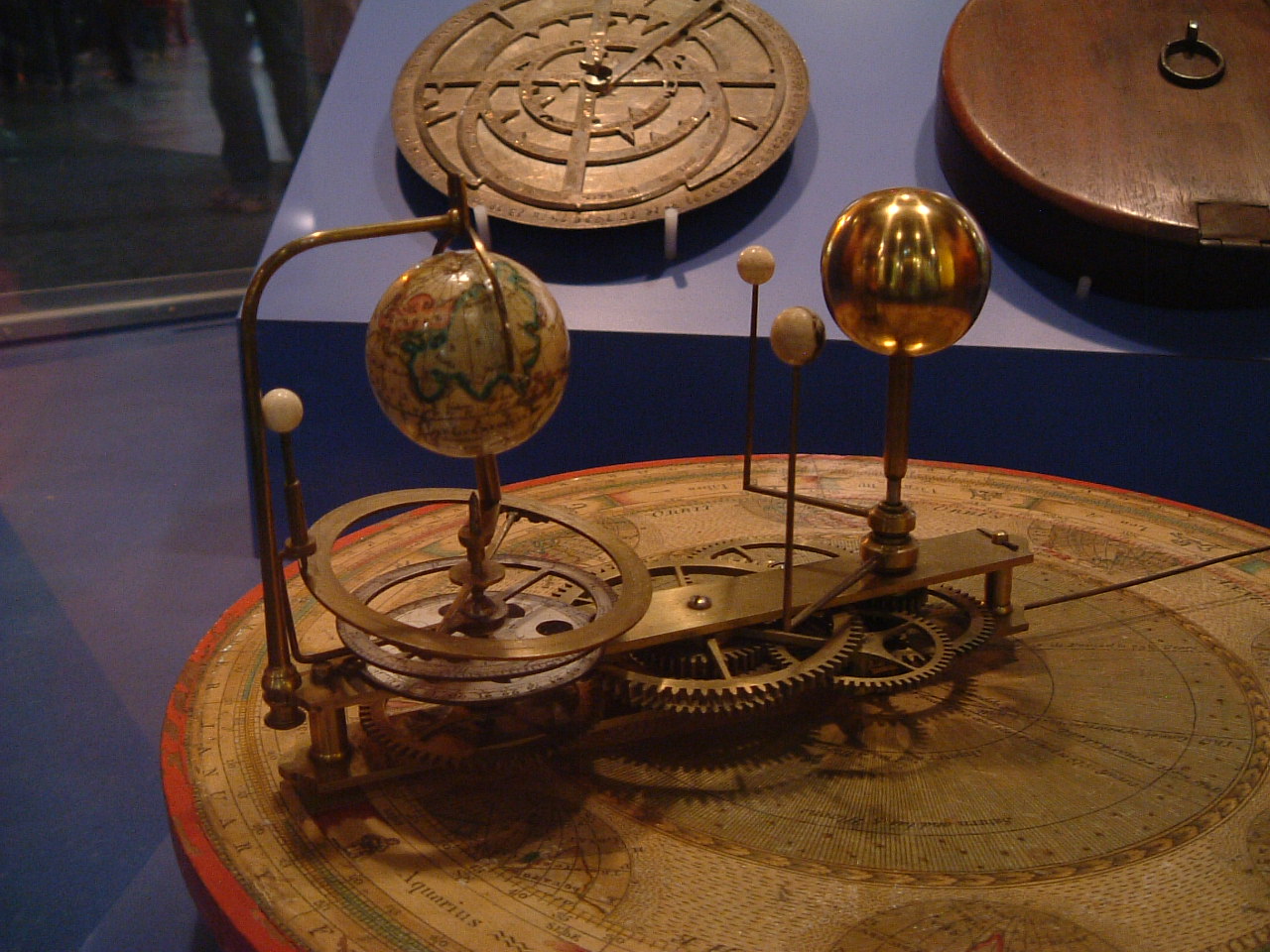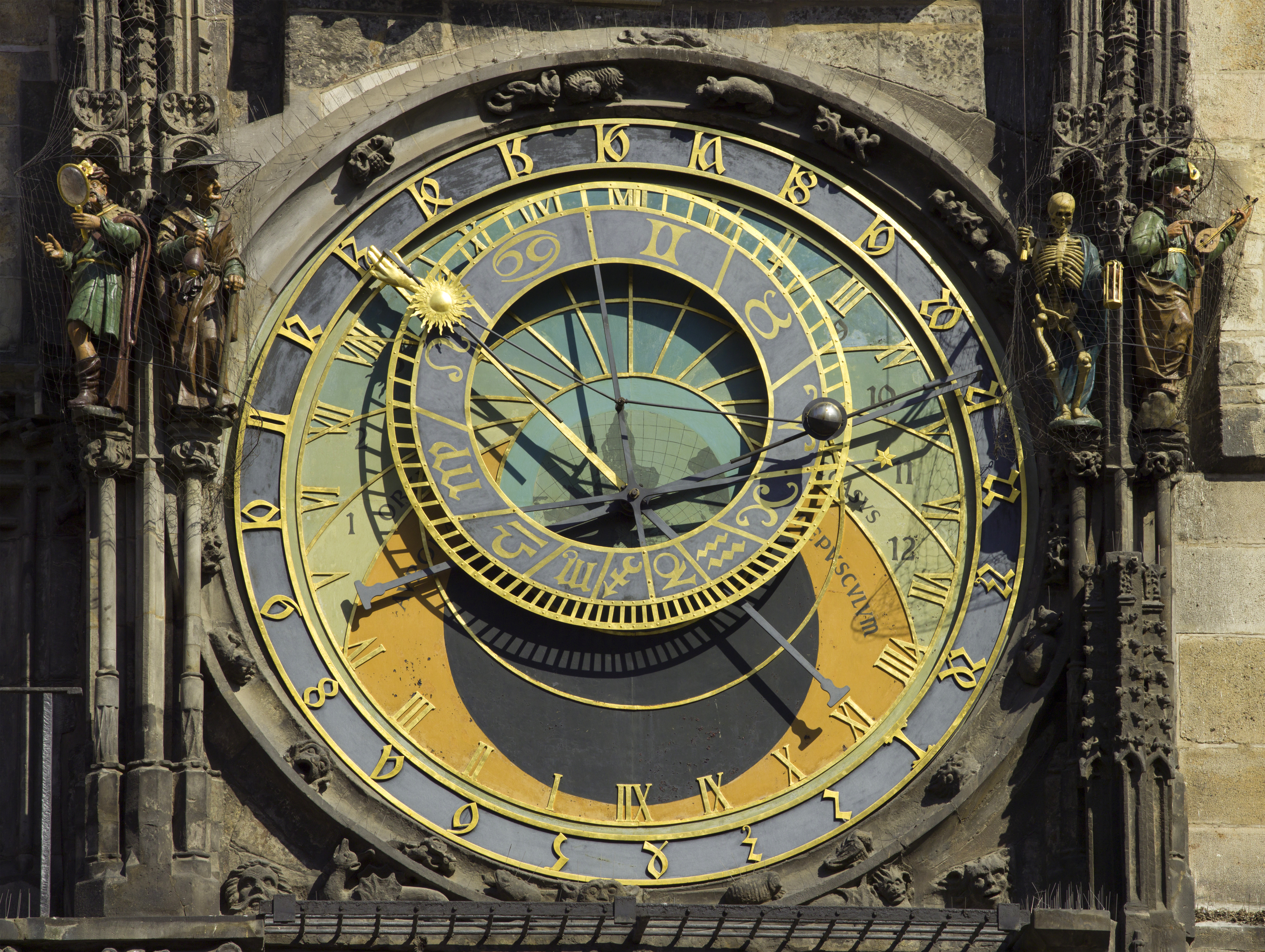|
Equatorium
An equatorium (plural, equatoria) is an astronomical calculating instrument. It can be used for finding the positions of the Moon, Sun, and planets without arithmetic operations, using a geometrical model to represent the position of a given celestial body. History Planetary equatoria were probably made by ancient Greeks, although no findings nor descriptions have been preserved from that period. In his comment on Ptolemy's ''Handy Tables'', 4th century mathematician Theon of Alexandria introduced some diagrams to geometrically compute the position of the planets based on Ptolemy's epicyclical theory. The first description of the construction of a solar (as opposed to planetary) equatorium is contained in Proclus's fifth-century work ''Hypotyposis'', where he gives instructions on how to construct one in wood or bronze. The earliest surviving descriptions of planetary equatoria are the Latin translations of Arab works contained in the '' Libros del saber de astronomia'' ('' ... [...More Info...] [...Related Items...] OR: [Wikipedia] [Google] [Baidu] |
Ibn Al‐Samḥ
Abū al‐Qāsim Aṣbagh ibn Muḥammad ibn al‐Samḥ al‐Gharnāṭī al-Mahri () (born 979, Córdoba, Spain, Córdoba; died 1035, Granada), also known as Ibn al‐Samḥ, was an Arab mathematician and astronomer from Al-Andalus. He worked at the school founded by Al-Majriti in Córdoba, until political unrest forced him to move to Granada, where he was employed by Habbus al-Muzaffar, Ḥabbūs ibn Māksan. He is known for treatises on the construction and use of the astrolabe, as well as the first known work on the equatorium, planetary equatorium. Furthermore, in mathematics he is remembered for a commentary on Euclid and for contributions to early algebra, among other works. He is one of several writers referred to in Latin texts as "Abulcasim." The exoplanet Samh, also known as Upsilon Andromedae c, is named in his honor as part of the IAU's NameExoWorlds project. References 979 births 1035 deaths 10th-century Arabs 11th-century Arabs 11th-century Al-Andalus pe ... [...More Info...] [...Related Items...] OR: [Wikipedia] [Google] [Baidu] |
Campanus Of Novara
Campanus of Novara ( 1220 – 1296) was an Italian mathematician, astronomer, astrologer, and physician who is best known for his work on Euclid's ''Elements''. In his writings he refers to himself as Campanus Nouariensis; contemporary documents refer to him as Magister Campanus; and the full style of his name is Magister Campanus Nouariensis. He is also referred to as Campano da Novara, Giovanni Campano or similar. Later authors (from the 16th century on) sometimes applied the forename Johannes Campanus or Iohannes Campanus. His date of birth is uncertain but may have been as early as the first decade of the 13th century and the place of birth was probably Novara in Piedmont. He served as chaplain to Pope Urban IV, Pope Adrian V, Pope Nicholas IV, and Pope Boniface VIII. His contemporary Roger Bacon cited Campanus as one of the two "good" (but not "perfect") mathematicians indicating that Bacon considered Campanus as excellent or one of the greatest mathematicians of their ... [...More Info...] [...Related Items...] OR: [Wikipedia] [Google] [Baidu] |
Astronomy
Astronomy () is a natural science that studies astronomical object, celestial objects and phenomena. It uses mathematics, physics, and chemistry in order to explain their origin and chronology of the Universe, evolution. Objects of interest include planets, natural satellite, moons, stars, nebulae, galaxy, galaxies, and comets. Relevant phenomena include supernova explosions, gamma ray bursts, quasars, blazars, pulsars, and cosmic microwave background radiation. More generally, astronomy studies everything that originates beyond atmosphere of Earth, Earth's atmosphere. Cosmology is a branch of astronomy that studies the universe as a whole. Astronomy is one of the oldest natural sciences. The early civilizations in recorded history made methodical observations of the night sky. These include the Babylonian astronomy, Babylonians, Greek astronomy, Greeks, Indian astronomy, Indians, Egyptian astronomy, Egyptians, Chinese astronomy, Chinese, Maya civilization, Maya, and many anc ... [...More Info...] [...Related Items...] OR: [Wikipedia] [Google] [Baidu] |
Planetarium
A planetarium ( planetariums or ''planetaria'') is a theatre built primarily for presenting educational and entertaining shows about astronomy and the night sky, or for training in celestial navigation. A dominant feature of most planetariums is the large dome-shaped projection screen onto which scenes of stars, planets, and other celestial objects can be made to appear and move realistically to simulate their motion. The projection can be created in various ways, such as a star ball, slide projector, video, fulldome projector systems, and lasers. Typical systems can be set to simulate the sky at any point in time, past or present, and often to depict the night sky as it would appear from any point of latitude on Earth. Planetaria range in size from the 37 meter dome in St. Petersburg, Russia (called “Planetarium No 1”) to three-meter inflatable portable domes where attendees sit on the floor. The largest planetarium in the Western Hemisphere is the Jennifer Chalsty Plan ... [...More Info...] [...Related Items...] OR: [Wikipedia] [Google] [Baidu] |
Richard Of Wallingford
Richard of Wallingford (1292–1336) was an English mathematician, astronomer, horologist, and cleric who made major contributions to astronomy and horology while serving as abbot of St Albans Abbey in Hertfordshire. Biography Richard was born, the son of a blacksmith, at Wallingford in Berkshire (now Oxfordshire) in England in 1292. When he was orphaned he was taken to William de Kirkeby the Prior of Wallingford Priory and dedicated to the Holy Trinity. (Wallingford was a dependant priory to S Albans Abbey) Richard subsequently spent six years studying at Oxford University before becoming a monk at St Albans. He later studied for nine more years at Oxford. In 1327 he became abbot of St Albans. Richard of Wallingford is best known for the astronomical clock he designed, while he was abbot, which is described in the ''Tractatus Horologii Astronomici'' (1327). The clock was completed about 20 years after Richard's death by William of Walsham but was apparently destroyed during ... [...More Info...] [...Related Items...] OR: [Wikipedia] [Google] [Baidu] |
Orrery
An orrery is a mechanical model of the Solar System that illustrates or predicts the relative positions and motions of the planets and moons, usually according to the heliocentric model. It may also represent the relative sizes of these bodies; however, since accurate scaling is often not practical due to the actual large ratio differences, a subdued approximation may be used instead. Though the Greeks had working planetaria, the first orrery that was a planetarium of the modern era was produced in 1704, and one was presented to Charles Boyle, 4th Earl of Orrery – hence the name. They are typically driven by a clockwork mechanism with a globe representing the Sun at the centre, and with a planet at the end of each of the arms. History Ancient versions The Antikythera mechanism, discovered in 1901 in a wreck off the Greek island of Antikythera in the Mediterranean Sea, (it now resides in the National Archaeological Museum of Athens) and extensively studied, exhibited the diu ... [...More Info...] [...Related Items...] OR: [Wikipedia] [Google] [Baidu] |
Astronomical Clock
An astronomical clock, horologium, or orloj is a clock with special mechanisms and dials to display astronomical information, such as the relative positions of the Sun, Moon, zodiacal constellations, and sometimes major planets. Definition The term is loosely used to refer to any clock that shows, in addition to the time of day, astronomical information. This could include the location of the Sun and Moon in the sky, the age and Lunar phases, the position of the Sun on the ecliptic and the current zodiac sign, the sidereal time, and other astronomical data such as the Moon's nodes (for indicating eclipses) or a rotating star map. The term should not be confused with ''astronomical regulator'', a high precision but otherwise ordinary pendulum clock used in observatories. Astronomical clocks usually represent the Solar System using the geocentric model. The center of the dial is often marked with a disc or sphere representing the Earth, located at the center of the Solar Sy ... [...More Info...] [...Related Items...] OR: [Wikipedia] [Google] [Baidu] |
Astrolabe
An astrolabe ( grc, ἀστρολάβος ; ar, ٱلأَسْطُرلاب ; persian, ستارهیاب ) is an ancient astronomical instrument that was a handheld model of the universe. Its various functions also make it an elaborate inclinometer and an analog calculation device capable of working out several kinds of problems in astronomy. In its simplest form it is a metal disc with a pattern of wires, cutouts, and perforations that allows a user to calculate astronomical positions precisely. Historically used by astronomers, it is able to measure the altitude above the horizon of a celestial body, day or night; it can be used to identify stars or planets, to determine local latitude given local time (and vice versa), to survey, or to triangulate. It was used in classical antiquity, the Islamic Golden Age, the European Middle Ages and the Age of Discovery for all these purposes. The astrolabe's importance comes not only from the early developments into the study of astron ... [...More Info...] [...Related Items...] OR: [Wikipedia] [Google] [Baidu] |
Astrarium
An astrarium, also called a planetarium, is the mechanical representation of the cyclic nature of astronomical objects in one timepiece. It is an astronomical clock. History Greek and Roman World The first astraria were mechanical devices. Archimedes is said to have used a primitive version that could predict the positions of the Sun, the Moon, and the planets. On May 17, 1902, an archaeologist named Valerios Stais discovered that a lump of oxidated material, which had been recovered from a shipwreck near the Greek island of Antikythera, held within it a mechanism with cogwheels. This mechanism, known as the Antikythera mechanism, was recently redated to end of the 2nd century BCE. Extensive study of the fragments, using X-rays, has revealed enough details (gears, pinions, crank) to enable researchers to build partial replicas of the original device. Engraved on the major gears are the names of the planets, which leaves little doubt as to the intended use of the mechanism. By t ... [...More Info...] [...Related Items...] OR: [Wikipedia] [Google] [Baidu] |
Armillary Sphere
An armillary sphere (variations are known as spherical astrolabe, armilla, or armil) is a model of objects in the sky (on the celestial sphere), consisting of a spherical framework of rings, centered on Earth or the Sun, that represent lines of celestial longitude and latitude and other astronomically important features, such as the ecliptic. As such, it differs from a celestial globe, which is a smooth sphere whose principal purpose is to map the constellations. It was invented separately first in ancient China during the 4th century BC and ancient Greece during the 3rd century BC, with later uses in the Islamic world and Medieval Europe. With the Earth as center, an armillary sphere is known as ''Ptolemaic''. With the Sun as center, it is known as '' Copernican''. The flag of Portugal features an armillary sphere. The armillary sphere is also featured in Portuguese heraldry, associated with the Portuguese discoveries during the Age of Exploration. Manuel I of Portugal, for ... [...More Info...] [...Related Items...] OR: [Wikipedia] [Google] [Baidu] |
Antikythera Mechanism
The Antikythera mechanism ( ) is an Ancient Greece, Ancient Greek hand-powered orrery, described as the oldest example of an analogue computer used to predict astronomy, astronomical positions and eclipses decades in advance. It could also be used to track the four-year cycle of athletic games which was similar to an Olympiad, the cycle of the ancient Olympic Games. This artefact was among wreckage retrieved from a Antikythera wreck, shipwreck off the coast of the Greek island Antikythera in 1901. On 17 May 1902, it was identified as containing a gear by archaeologist Valerios Stais. The device, housed in the remains of a wooden-framed case of (uncertain) overall size , was found as one lump, later separated into three main fragments which are now divided into 82 separate fragments after conservation efforts. Four of these fragments contain gears, while inscriptions are found on many others. The largest gear is approximately in diameter and originally had 223 teeth. In 2008, ... [...More Info...] [...Related Items...] OR: [Wikipedia] [Google] [Baidu] |
Horoscope
A horoscope (or other commonly used names for the horoscope in English include natal chart, astrological chart, astro-chart, celestial map, sky-map, star-chart, cosmogram, vitasphere, radical chart, radix, chart wheel or simply chart) is an astrological chart or diagram representing the positions of the Sun, Moon, planets, astrological aspects and sensitive angles at the time of an event, such as the moment of a person's birth. The word horoscope is derived from the Greek words ''ōra'' and ''scopos'' meaning "time" and "observer" (''horoskopos'', pl. ''horoskopoi'', or "marker(s) of the hour"). It is used as a method of divination regarding events relating to the point in time it represents, and it forms the basis of the horoscopic traditions of astrology. Horoscope columns are often featured in print and online newspapers. In common usage, horoscope often refers to an astrologer's interpretation, usually based on a system of solar Sun sign astrology; based strictly on the pos ... [...More Info...] [...Related Items...] OR: [Wikipedia] [Google] [Baidu] |









